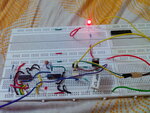chinuhark
Member level 5
To all Power Electronics experts out there,
I have a masters degree in power electronics, have done V/F successfully, made a hysteresis and PI based current controlled Inverters, done Thyristor control, mastered the dsPIC controller and so on. But a thing that has still eluded me and all my colleagues at my college is to make a ROBUST Inverter that does not blow up. After giving up on the idea of Power Circuit Design a few months back, I have decided to take it up as a challenge to make one.
This is what has inspired me:
https://tahmidmc.blogspot.in/2012/09/failure-is-pillar-of-success.html
I have done a lot of research online about IGBTs, gate drivers, blown up many IR2110s, studied PCB layout considerations, OC/SC protection, current sensors and so on but none of my designs has ever lasted for long when loaded by an actual motor. The waveforms were perfect, but smoke was always imminent. I don't know whether I was doing something very wrong or was just too damn unlucky. I don't know if this is a very simple task I am making a lot of fuss over.
My first question to you all is:
Does everyone blow up their first few inverters or is this something that should be quite straightforward?
I will be posting about my progress on this thread and request all of you to support this thread by providing your valuable opinions.
The basic plan right now is as follows:
- 2kW, 415V 3 Phase IGBT bridge
- Over Current and Short Circuit Protection
- DC Caps Precharge circuit
- Thermal Protection using thermistor
This brings me to question2:
Single IGBT or IGBT Module(without driver) or Intelligent Power Module(IPM)?
I am slightly reluctant to go the IPM route.
I have a masters degree in power electronics, have done V/F successfully, made a hysteresis and PI based current controlled Inverters, done Thyristor control, mastered the dsPIC controller and so on. But a thing that has still eluded me and all my colleagues at my college is to make a ROBUST Inverter that does not blow up. After giving up on the idea of Power Circuit Design a few months back, I have decided to take it up as a challenge to make one.
This is what has inspired me:
https://tahmidmc.blogspot.in/2012/09/failure-is-pillar-of-success.html
I have done a lot of research online about IGBTs, gate drivers, blown up many IR2110s, studied PCB layout considerations, OC/SC protection, current sensors and so on but none of my designs has ever lasted for long when loaded by an actual motor. The waveforms were perfect, but smoke was always imminent. I don't know whether I was doing something very wrong or was just too damn unlucky. I don't know if this is a very simple task I am making a lot of fuss over.
My first question to you all is:
Does everyone blow up their first few inverters or is this something that should be quite straightforward?
I will be posting about my progress on this thread and request all of you to support this thread by providing your valuable opinions.
The basic plan right now is as follows:
- 2kW, 415V 3 Phase IGBT bridge
- Over Current and Short Circuit Protection
- DC Caps Precharge circuit
- Thermal Protection using thermistor
This brings me to question2:
Single IGBT or IGBT Module(without driver) or Intelligent Power Module(IPM)?
I am slightly reluctant to go the IPM route.


